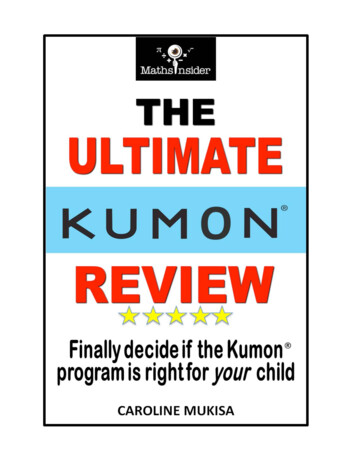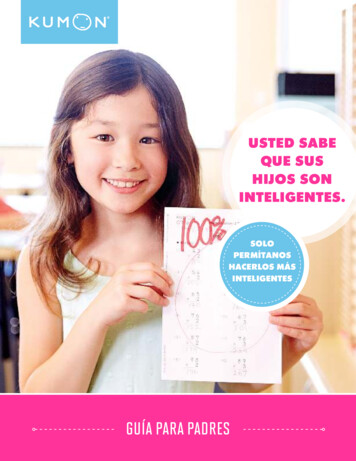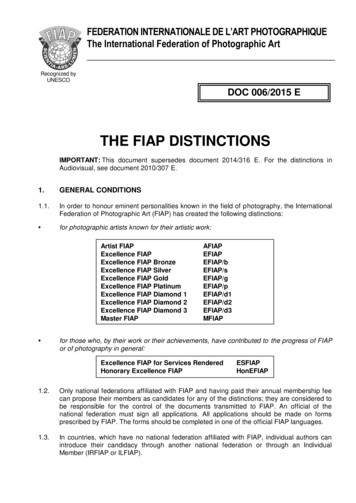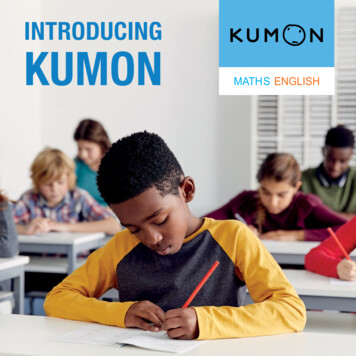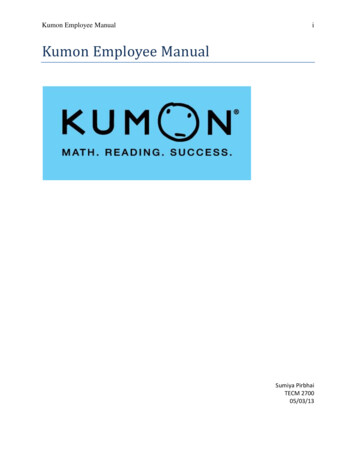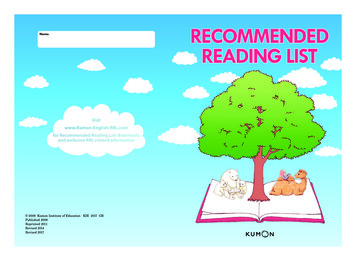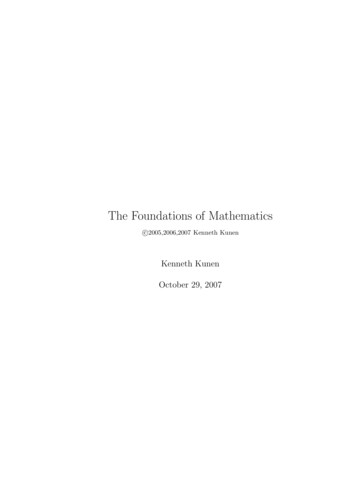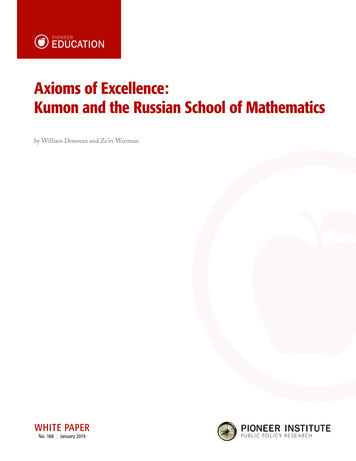
Transcription
Axioms of Excellence:Kumon and the Russian School of Mathematicsby William Donovan and Ze’ev WurmanWHITE PAPERNo. 188 January 2019
PIONEER INSTITUTEPioneer’s MissionPioneer Institute is an independent, non-partisan, privately funded research organization that seeks to improve the qualityof life in Massachusetts through civic discourse and intellectually rigorous, data-driven public policy solutions based on freemarket principles, individual liberty and responsibility, and the ideal of effective, limited and accountable government.This paper is a publication of Pioneer Education, which seeks to increase the educationoptions available to parents and students, drivesystem-wide reform, and ensure accountabilityin public education. The Center’s work buildson Pioneer’s legacy as a recognized leader in thecharter public school movement, and as a champion of greater academic rigor in Massachusetts’elementary and secondary schools. Current initiatives promote choice and competition, schoolbased management, and enhanced academicperformance in public schools.Pioneer Health seeks to refocus the Massachusetts conversation about health care costs awayfrom government-imposed interventions, towardmarket-based reforms. Current initiatives includedriving public discourse on Medicaid; presenting a strong consumer perspective as the stateconsiders a dramatic overhaul of the health carepayment process; and supporting thoughtful tortreforms.Pioneer Public seeks limited, accountable government by promoting competitive delivery ofpublic services, elimination of unnecessary regulation, and a focus on core government functions.Current initiatives promote reform of how thestate builds, manages, repairs and finances itstransportation assets as well as public employeebenefit reform.Pioneer Opportunity seeks to keep Massachusetts competitive by promoting a healthy businessclimate, transparent regulation, small businesscreation in urban areas and sound environmental and development policy. Current initiativespromote market reforms to increase the supplyof affordable housing, reduce the cost of doingbusiness, and revitalize urban areas.Pioneer Institute is a tax-exempt 501(c)3 organization funded through the donations of individuals, foundations and businessescommitted to the principles Pioneer espouses. To ensure its independence, Pioneer does not accept government grants.i
A XIOMS OF E XCELLENCE: KUMON AND THE RUSSIAN SCHOOL OF MATHEMATICSTable of ContentsIntro-background 4After School Programs on the Rise 5Kumon Centers 5An early start 6Math vs Applied Math 7Instructors, not teachers 8Russian School of Mathematics 9Benefits of starting early 9Conclusion and Recommendations 11Appendix 14
A XIOMS OF E XCELLENCE: KUMON AND THE RUSSIAN SCHOOL OF MATHEMATICSIntro-backgroundThe causes given for this flattening of math and scienceoutcomes vary. Poor teacher training has been cited by somecritics, vague teaching standards among others, inadequateschool funding by still more. In 2016 the Brown Center onEducation Policy at the Brookings Institution in Washington,D.C., surveyed more than 250 international students to gettheir views on U.S. schools. A common opinion was that theyare much less challenging than those in their home countriesand that American teens are more focused on success in sportscompared to their peers back home.7A 2016 report by the National Center on Education andthe Economy (NCEE) argued that U.S. elementary schoolstudents struggle with math because teachers don’t know itwell enough compared with top-performing countries andterritories such as Finland, Japan and Hong Kong. The reportstated that those countries have higher selectivity standardsfor teachers than the U.S. It said that, while many Americanprimary school teachers teach all subjects, in the top countriesteachers specialize in math, history or science.8But the NCEE report is wrong. Only Finland is highlyselective in its choice of teachers, and the early Finnish successon PISA was broadly criticized by its own math educators forignoring the skills needed for math-based STEM postsecondary programs.9 Between 2003 and 2015 the PISA math scoresof the Finnish students have dropped sharply.10 Elementaryteachers in Japan and China do not specialize in math orhistory as the NCEE report claims, but rather are assigned asubject by school principals and specialize over time throughon-site training and mentoring. They may also benefit froma stronger content knowledge gained in their high schools.11Schools in many U.S. communities are investing more inteacher training, but whether that is actually paying off is anopen question. Schoolslike the John Muir EleIn Massachusetts, thementary School in Sanprogress that eighth gradersFrancisco think it does,yet the improvementwere once making inin students’ scores maymath in the Massachusettsbe attributable more toComprehensive Assessmentteachers’ learning theexpectations of the newSystem (MCAS) hasSmarter Balanced assessslowed in recent years.ment than to the growthin teachers’ knowledgeor understanding.12 In fact, two recent and methodologically excellent studies found that intensive teacher training inmathematics had no effect on students’ scores.13 The Gates’Foundation’s Measures of Effective Teaching (MET) projectspent three years and 575 million to conclude that, as a sympathetic pundit put it, “We don’t yet know enough about howThe acronym STEM stands prominently in United Stateseducation. Grouping together the brainy disciplines of science, technology, engineering and mathematics, its excellenceis considered vital for national security, world class innovationand owning the future. The competition is fierce out there, saypoliticians and corporate leaders, and if America is to surviveit needs to produce the best.But the numbers are in and they are not inspiring. In themost recent National Assessment of Educational Progress, anexam given by the federalDepartment of EducaBut the numbers are intion and often called “theand they are not inspiring. Nation’s Report Card,”average math scores foraverage math scores foreighth graders and fourtheighth graders and fourthgraders fell in 2015 forgraders fell in 2015 for thethe first time since 1990.1The math scores for thefirst time since 1990.12017 exams remainedThe math scores for theunchanged from 2015.2Nor are U.S. students2017 exams remainedstacking up well against2unchanged from 2015.students in other countries. According to theProgramme for International Student Assessment (PISA), anexam offered every three years to measure reading ability andmath and science literacy skills among 15-year-olds, the U.S.ranked 31st out of 70 countries in 2015. In math specificallythe U.S. was 39th, tied with Israel and a few points behindSlovakia and Hungary. In science the U.S. was 25th, slightlybehind Norway and Portugal and a point ahead of Austria.3A third exam conducted in 2015 was slightly more encouraging. The Trends in International Mathematics and ScienceStudy, (TIMSS) which is given to nearly 600,000 studentsin dozens of education systems around the world every fouryears, reported that the average score of U.S. eighth gradersrose slightly from results in 2011. Still, the United Statestrailed Singapore by 66 points in eighth-grade science and by103 points in eighth-grade math.4Scores from the ACT math college-entrance exam havealso shown troubling declines. The graduating class of 2018posted an average score of 20.5, continuing a slide from the 21.1average score of six years ago and back below the 20.6 averagescore recorded in 1998.5 In Massachusetts, the progress thateighth graders were once making in math in the MassachusettsComprehensive Assessment System (MCAS) has slowed inrecent years. From 2015 to 2017 the number of eighth-gradestudents scoring in the “Below Basic” category rose from 15percent to 19 percent. That reversed a positive trend that beganin 1992, when the percentage of students scoring at that levelbegan to decline from a high of 37 percent.64
A XIOMS OF E XCELLENCE: KUMON AND THE RUSSIAN SCHOOL OF MATHEMATICSto find individuals who will eventually become great educatorsor how to train people to get there . but one of the study’smost important findings is that observations—long the coreof evaluation systems—are far less predictive than anyonewanted to believe.” 14 In other words, knowing what makes ateacher effective, and in particular putting one’s trust in yetanother professional development program, may not be thewisest expenditure of money.feeling on the part of some parents that their child is beingpoorly served by their classroom instruction regardless of theirchild’s aptitude. Perhaps the teacher is lacking or the parentshave qualms with the school’s curriculum. Accordingly theydecide to go elsewhere.While Star calls the parents’ concerns “legitimate,” he alsosays it is “rare that parents have a sufficiently accurate read onthe quality of instruction in the class or the quality of the curriculum being used to make a judgment to take their kids andput them in extra math for those reasons.” 17Programs such as Kumon, the Russian School of Mathematics (RSM) and others have their supporters. Parentscan find largely positive “reviews” from other parents of localcenters on the website Yelp, as if searching for a restaurantrecommendation. Four-and-a-half stars to a Kumon Centerin Quincy, MA, three-and-a-half stars to a Russian School ofMath center in Lexington, MA, and so on.But there are critics as well. Hilary Kreisberg, director ofthe Center for Math Achievement at Lesley University, saysmany after-school programs promote critical thinking anddeep understanding of mathematics on their web sites, but sheoften finds the focus has been on procedure and computationwhen working with their students.“We’re rooted in the same philosophy,” says Kreisberg ofclassroom instruction and after-school programs. “We wantkids to be successful and we understand that there are teachingpractices that benefit students. But there is some divergence interms of today’s instruction of mathematics and the need forthe critical thinking versus what is actually happening.” 18This paper will look at the popularity of after-school mathematics by focusing on the Kumon and Russian School ofMathematics models. It will review their methods, highlighttheir best practices, and show how they complement or runparallel with mathematics taught in traditional classrooms.After School Programs on the RiseFor many parents the solution to flat scores and poor preparation has been to turn to outside math instruction, propelling the growth of private after-school mathematics programs.National numbers are hard to come by, but in the Bostonarea more than a dozen private companies offer enrichmentprograms at nearly 50 locations. Kumon Centers, the world’slargest after-school math and reading organization, has morethan 1,500 locations in the U.S. serving nearly 300,000 students. The Russian School of Math, based in Newton MA,has grown to 46 locations in 11 states, plus two in Toronto,Canada since its founding in 1997.Jon Star, an educational psychologist at the Harvard University Graduate School of Education, points to several reasons why parents are enrolling their children in after-schoolprograms. The first is that they often have an idea of what theythink math should look like, independent of what the schoolis engaged in. They send theirkids to the after-school proToru’s goal was to teach gram to get what they believe ismissing.15Takeshi how to learnThat parental anxiety is alsoindependently throughdriven by a “keeping-up-withthe-Joneses” attitude, says Star,the worksheets andeven though after-school proimprove his calculationgrams thrive in high socio-ecoskills prior to reachingnomic status areas, where publiceducation is well regarded andhigh school.many students attend privateschools. They enroll their children in supplemental programs despite the fact they’re alreadyreceiving an excellent education.Star says that many parents feel their kids are extraordinarily interested in math or show unusual aptitude but are notreceiving the individual attention they need to maintain thatinterest in the classroom.“It might be that parents feel that a particular teacher is notas skilled at giving their kids the enrichment they need or theyfeel their kid is super interested in math and they want to givethem extra experiences in math,” he says. “That’s a great reasonfor parents to look for these extra programs.” 16A third reason for their increased interest could be aKumon CentersIn 1954, Toru Kumon, a high school math teacher in Japan,designed a series of math worksheets to help improve the testscores of his son Takeshi, a second grader. Toru’s goal was toteach Takeshi how to learn independently through the worksheets and improve his calculation skills prior to reachinghigh school. By working every day on the problems, Takeshiwas able to reach the level of differential and integral calculuswhen he was just a few months into the sixth grade.19After seeing the impact of the math sheets on Takeshi,Toru Kumon invited other local children to study at his home.Their improved skills led to the opening of an office in 1958and a steady climb of thousands of enrolled students. Aftergrowing in Japan, Kumon expanded internationally in the1970s, opening in New York, Taiwan, Brazil and Germany.More Kumon Centers followed in Spain, Australia, Africa and5
A XIOMS OF E XCELLENCE: KUMON AND THE RUSSIAN SCHOOL OF MATHEMATICSto supplement school work, Kumon provides individualizedinstruction. New students take a placement test that measurestime and accuracy on solving problems in their grade level.Instructors use the results to select the appropriate beginningmath worksheets.Self-learning. The worksheets include directions andexercises, and students work independently on them to develop self-confidence. Each student has daily assignments thattake about 30 minutes to complete. Two days each week thestudent completes assignments at the Kumon Center. Otherdays the work is done at home.Small-step worksheets. Each worksheet Kumon studentsare given is one-step higher in difficulty than the one before.Students attempt to build a foundation of knowledge by proving they understand each level of math before advancing. Theinternational version of the Kumon Math Program consistsof 20 levels, including preschool (from Level 6A to Level O)and five elective levels, involving a total of more than 4,400double-sided worksheets.24Kumon instructors. Although students work independently and are encouraged to solve problems on their own,when they are stuck on a worksheet problem Kumon instructors provide hints based upon what the student already knows.Building self-confidence is a high priority at Kumon.When students begin the program, they’re given a placementtest that measures time and accuracy on solving problems intheir grade level. The results are used to establish a startingpoint where they canbegin with little difficulty. A third-grade“ We aim to get new studentsstudententeringto grade level within 12 monthsKumon, for examof enrollment and then we aimple, would be givena test that beginsto get them at least three yearswith addition andbeyond grade level so wesubtraction, has somemultiplicationandcan get them to high schoola smaller amount oflevel math as quickly asdivision. The startingpossible,” says Mary Mokris,”point is usually belowtheir level of masteryeducation specialist forso they can developKumon North America.22their concentration,work skills and beliefin their abilities. Students progress through the math sheets at their own pace.“(Kumon) provides individual goals based on kid-specific needs,” says Jennifer Gallagher, a mother of two boys whoattend the Kumon center in Hanover, MA. “Whatever they’renot getting met (in school), they can fill in the gaps. I feel likeschool can be positive or negative and when you go there it’svery positive.”25elsewhere around the world. Today, in its 60th year of operation, 4.2 million students are studying at nearly 25,000 learning centers in 50 countries and regions.20 In the U.S. alone,Kumon has grown frommore than 182,000 stuParents who want to givedents and nearly 1,300their children a head startcenters in 2008 to morethan 279,000 studentsin math before elementaryand more than 1500school can enroll them incenters in 2018.21Kumon has 45 locaKumon as young as agetions in Massachusetts,3. they can stay with the19 in or along the Routeprogram through high128 beltway includingLexington, Needham,school or until theyNewton,Dorchestercomplete the program.and Brookline. They arelocated west of Boston inWorcester, Shrewsbury and Hopkinton; to the north in Lowell, Andover and Beverly and south to Kingston, Mansfieldand Norwell.An early startParents who want to give their children a head start in mathbefore elementary school can enroll them in Kumon as youngas age 3. From that age they can stay with the program throughhigh school or until they complete the program. Completingthe program means a child has reached high school level mathand can handle differential equations. How quickly they reachthat level depends on each individual. Students progress as faras they can, as quickly as they can.“We aim to get new students to grade level within 12months of enrollment and then we aim to get them at leastthree years beyond grade level so we can get them to highschool level math as quickly as possible,” says Mary Mokris,education specialist for Kumon North America.22Kumon touts its program as offering its greatest valuefor students who stick with it over time. “Parents who viewKumon as a valuable, ongoing extracurricular activity — suchas guitar lessons or sports, for example — often watch theirchild build an academic and confidence edge that helps themachieve more, year after year in school.” 23Kumon officials say they do not keep data on how theirstudents perform on national tests such as the SAT or thebefore-and-after effect of their methods on student grade pointaverages. Mokris says the Kumon program “is individualizedfor each student so our results are different for each student.”Student growth is assessed starting from the placement testthroughout enrollment.Kumon describes its approach in four parts:Individualized instruction. As a curriculum designed6
A XIOMS OF E XCELLENCE: KUMON AND THE RUSSIAN SCHOOL OF MATHEMATICSMath vs Applied Mathbits and pieces and struggle, while if we have automaticitywith basic arithmetic operations, terms like “five sets of threeMokris says the Kumon program is focused on “mathematicsapples” are directly held in the brain’s working memory as “15”itself,” as opposed to the applied mathematics found in wordrather than as three “facts” (three, five, and “multiply”).problems. It starts with counting and continues through difIn other words, arithmetic fluency greatly expands ourferential equations and beyond. The sequential nature of theability to tackle more complex problems as we are not heldprogram allows young children to progress from buildingback by flooding our working memory with trivial details.numeracy skills with counting to the arithmetic basics of addiThe bad name schools give to what they disdainfully call “rotetion, subtraction, multiplication and division, into fractions,26memorization” and computation is actually hurting students’and progressing to advanced calculus.ability to solve higher-order problems. In that sense KumonHarvard’s Jon Star has worked with Kumon studentsusefully fills an area neglected by modern American educators,through his classroom research in Boston’s public schools. Hewho seem to have forgotten a century-old admonition of onesays that in the mathematics debate of learning concepts vs.of the giants of mathematics and philosophy.skills, Kumon comes down on the skills side by “routinizing”important math abilities. Those proficienIt is a profoundly erroneous truism thatcies could include recall of multiplicationParents of students attendingwe should cultivate the habit of thinking offacts, for example, or the ability to fluentlyKumonagreethatitfocuseswhat we are doing. The precise opposite isdo certain kinds of computations.the case. Civilization advances by extendParents of students attending Kumonon climbing the mathematicsing the number of important operationsagree that it focuses on climbing theladder. Caitlin McCarthy, awhich we can perform without thinkingmathematics ladder. Caitlin McCarthy,about them. - Alfred North Whiteheada middle school math teacher, has twomiddle school math teacher,daughters enrolled in the Kumon center inhas two daughters enrolled.Hilary Kreisberg of Lesley UniversityNorwell, MA. One is in the sixth gradeShe sees Kumon giving themargues that while it might be impressiveand the other in the fourth grade. Bothhave been attending Kumon since thethe “basic fluency they need.” when a young student is performingwell ahead of grade level, there needsfirst grade. She sees Kumon giving themBut Kumon is not aboutto be understanding behind the perforthe “basic fluency they need.” But Kumonmance.is not about problem solving or criticalproblem solving or critical“Any kid can plug in numbers to anthinking, she says.thinking, she says.equation and get an answer for X,” she“When my daughter in the sixth gradesays. “But do they know what they’reis doing math, she can do all the algodoing? If you can’t explain the math and communicate therithms and she can factor with her eyes closed,” she says. “Butmath and come up with more than one way to solve a problem,in the classroom she’s being asked to model it and to learnto me you’re not really a mathematical thinker.” 28more about the whys and apply it to problem solving and colMokris concurs that in classrooms the Common Corelaborate with group members and do some stuff on line.State Standards typically emphasize the application of mathe“She’s working on the quadratic formula,” she adds. “Shematics. Kumon’s focus is on “pure mathematics.” But she saysknows how to factor things, she knows how to apply thethere is a difference between rote memorization and focusingsquare root, she can rationalize denominators of square roots.on mathematics itself. By learning something until it becomesShe’s doing all that stuff, but it’s not problem solving. She’s notautomatic, such as the scales to play the piano, a person candoing it in the context of a real world problem.” 27then move on to more challenging levels, such as playing aYet in that situation she still sees Kumon as part of acomposition by the 19th century composer Carl Czerny.larger process of educating her daughter. The Kumon methodLearning the notes requires more memorization, but memoincludes practicing formulas, while the classroom work teachrizing the baseline scales enables that next step.es her how to select the correct formula to solve a problem.In the Kumon method, Mokris says the brain commitsMcCarthy says that once her daughter selects the formula “shefacts to memory and builds strong neural pathways making itcan do the rest with her eyes closed.”possible for the student to answer correctly, even when facedResearch supports McCarthy’s observations. The brain canwith many different problems. As with other skills peoplemanipulate only a handful of new concepts at a time in itsbuild, mathematics is learned through mastering concepts andworking (short-term) memory, but it can manipulate essentialthen moving on to more challenging ones.ly an unlimited number of concepts/facts stored in our longMany mathematicians dismiss the argument that to showterm memory. When we are exposed to a problem that has areal understanding of math, one must be able to explain ithandful of variables and operations among them, our workingin words or always come up with multiple solutions.29 Manymemory gets quickly overloaded and we tend to forget (drop)7
A XIOMS OF E XCELLENCE: KUMON AND THE RUSSIAN SCHOOL OF MATHEMATICSstudents, particularly in early grades, find it difficult to explainBoth were concerned that their children were becoming disthe reason for every step they take in solving a problem. Thisengaged and turned to Kumon to supplement their schooloften looks akin to asking a bike rider to explain in detail whywork. In each case the parents were pleased with the advancedhe changed gears when he did, pedaled slower or faster, or howmath their children were receiving, while making it clear theyhe initially got on a bike without falling. A competent riderstill had responsibilities in school.does his movements automatically and successfully, and argu“He’s not more ahead in school, because he still has to doing that he “cannot be a competent rider until he can explainthe same things at school,” Gallagher says of her son in theit” seems wrong-headed. In fact, the onlyseventh grade. “The supplemental prothing such expectation accomplishes is togram will challenge him to the level he’sParents turn to after-schoolstop him from being a competent rider, asat. But we explained to him that at school,he now spends most of the time “explainhe has to do his work and if he does it well,programs not only asing” things that he does—and must do—that’s fine.”remedial work for laggingmostly instinctively and automatically. TheCoincidently, both Gallagher andexplaining is more the role of the teacherstudents, but for enrichment McCarthy have younger children at(or the riding instructor) rather than theKumon who have less aptitude at mathfor high-achievers. Theystudent.than their older children. With them,see their children excellingSimilarly, always expecting multiplethey see Kumon filling gaps and helpingsolutions seems unnatural and counterto catch up with school work.and want to encourageproductive. There are many ways—algoMcCarthy, the middle school maththeirtalentorensurerithms—to successfully perform arithmeteacher, wants to ensure that her youngertic operations, yet the point for students isdaughter’s foundation is solid to avoid herthat they don’t grow boredto be consistently effective and successfulbecoming discouraged in later grades. “Byby school work.doing it some way, rather than regularlyeighth grade a lot of them are frustratedshowing he can do it in multiple ways. Thewith math,” she says. “In the elementarypurpose, after all, is to get the result of the operation to serveschool, if you don’t fill in the gaps, everything snowballs andas the basis for the next step, rather than show off the abilitythey lose their confidence and by the eighth grade they aren’tto do it multiple ways. Again, we would likely be better offmotivated. I feel my kids will be more apt to be challenged.”leaving much of the “multiple ways” to teachers rather thanregularly expecting it from students. Multiple ways shouldInstructors, not teachersbe better encouraged through posing problems that naturallyKumon Centers in the U.S. are franchises, owned and operrequire different approaches, rather than through insisting onated by the center “instructors.” Though a background in eduapplying multiple approaches to problems that do not naturalcation is helpful, it is not required to own a franchise. Rather,ly fit them.investors must have a four-year college degree and be profiParents turn to after-school programs not only as remedialcient in reading and math. The estimated capital necessary towork for lagging students, but for enrichment for high-achievestablish and market a center is 70,000 in liquid capital and aers. They see their children excelling and want to encouragenet worth of 150,000.31their talent or ensure that they don’t grow bored by school work.After franchise applicants pass a background and financialThe irony is that by receiving extra math tutoring after school,qualificationscheck, they attend a 12-day franchisee trainingstudents advance even further ahead of their school curriculum,and instructor-development program at a regional office andraising the risk they’ll become uninterested in school.at Kumon University in New Jersey. Mokris says the franchi“It’s an unintended consequence,” says Star. “In manysee applicants include lawyers, scientists and engineers. Thecases, by sending your kid to the extra math, you’ll makedevelopment program teaches them about the materials they’llthem more bored in class. I’ve been in math classes where theuse and how to instruct students. It also trains them in thekids in the class already know the content that they’re beingKumon method from enrollment to ensuring the student istaught that day. They’re just bored because they’ve learned itplaced properly to making sure the instructors are correctlyprior to that class.”observing the students in the center.Kreisberg says the boredom risk can be offset by the classNotably, Kumon instructors are not referred to as “teachroom instruction. “If I’m creating a fun mathematics lessoners.”Mokris says the term instructor is preferred to keep theand it’s based on a real-world experience, and I’m showingfocuson self-learning. Rather than teaching a class, instruckids how it relates to the math, that’s not boring. Projects andtorsstepin only when necessary and provide the materialsproblem-based learning is really powerful. It comes down toonly as needed. Mokris says Kumon instructors have a deepthe planning and preparation and the thought behind it.” 30knowledge of the materials and can guide students to do theirGallagher and McCarthy both had children who showedbest self-learning.advanced math skills, such as multiplication, at a young age.8
A XIOMS OF E XCELLENCE: KUMON AND T
ematics by focusing on the Kumon and Russian School of Mathematics models. It will review their methods, highlight their best practices, and show how they complement or run parallel with mathematics taught in traditional classrooms. Kumon Centers In 1954, Toru Kumon, a high school math teacher in Japan,
